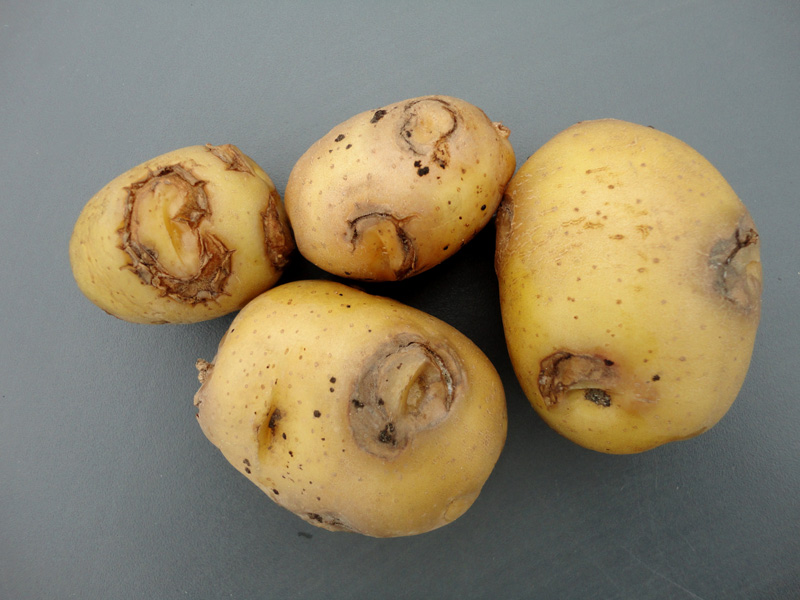Polish name: Wirus nekrotycznej kędzierzawki tytoniu
English name: Tobacco rattle virus, TRV
Kod EPPO: TRV000
Gallery

Severe infection with the rattle virus (TRV) can also manifest as ring necrosis on tubers
(photo: S. Wróbel)
Characteristics and Description of the Disease
The first symptoms on tubers in the form of necrosis of the flesh were observed in the USA in 1946. Initially, it was thought to be a new virus. Only later, thanks to newer diagnostic methods, it was proven that the observed symptoms are the result of TRV. The “rattle” virus most commonly occurs in light, moist soils, often on irrigated plantations. TRV belongs to the Tobravirus group, Virgaviridae family. It has a very broad range of host plants – over 400 species, including peony, sunflower, garlic, iris, tulip, barley, corn, potatoes, beets, spinach, peppers, cucumbers, beans, peas, cabbage plants, and many weeds. On many of these plants, it does not cause symptoms. The virus usually does not move within the plant and often remains in the roots of infected hosts; however, in the case of peonies and potatoes, it can also appear in the above-ground parts, causing symptoms on the leaves.
The main sources of rattle virus infection are commonly occurring weeds in potato cultivation (white goosefoot, common chickweed, field violet, common groundsel, bindweed, bird knotweed, common dandelion), and secondarily, seed tubers. It is mainly transmitted from infected plants to other plants by free-living soil nematodes of the Trichodorus and Paratrichodorus genera, a capability possessed by both larvae and adult individuals. Nematodes are highly mobile in the soil profile, and they can be found even at a depth of 1 meter. However, it is not known how far they can move horizontally. Their movement is hindered in heavy and compacted soils. The virus can survive in the nematode for 2 to 4 years. TRV can also be transmitted through canary seeds and may be mechanically transmitted. The use of manure containing weed seeds with TRV can be an additional source of infection.
The harm caused by the virus involves reducing yield and deteriorating the quality of tubers, which, due to flesh defects, are not suitable for sale or processing into products such as chips or fries. Yield reduction due to TRV infection can be up to 30%, but losses due to the deterioration of tuber quality are significantly greater. Legal regulations specify the maximum infection of seed tubers with viruses for different qualification classes, but currently in Poland, there is no testing of seed tubers for the presence of this virus, so there are no specific standards for it.
Symptoms of TRV infection are rarely visible on the above-ground part of the potato plant. They are much more commonly observed on the tubers. Characteristic symptoms that can be encountered after infection with this virus include:
stunted plant growth, small yellow, sometimes quite bright spots on the leaves, turning into necrotic spots, including on the stems, concentrically outlined necroses on the tubers (photo 1) very similar to the symptoms of PVYNTN infection, deformation of tubers, in the flesh, necroses arranged in characteristic clusters, crescents, or circles (photo 2TRV), symptoms of infection are particularly well visible in periods of low temperatures, with differences in symptoms depending on the virus strain, potato variety, and humidity.
Protection Methods:
There are no effective direct methods to combat viruses. There are resistant or highly resistant varieties to TRV, but information on this is limited. Resistant varieties include Bintje (completely resistant to TRV), Caesar, Fianna, Hermes, Lady Rosetta, Romano, Symfonia, and Viola. As seen, these are mainly foreign varieties. There is no such information for Polish varieties due to the lack of resistance studies in this regard in Poland.
Since the environment in which the virus spreads is the soil, the most effective method is to avoid growing potatoes in infected fields or at least implement a 4-year potato rotation at a given site. The population of nematodes in the soil can increase during the cultivation of cereals. Therefore, soil from such sites should be tested for the presence of nematodes of the Trichodorus and Paratrichodorus genera. Avoiding irrigation on fields where nematodes and TRV are present is recommended since nematodes are usually more active in wet soil.
Due to the virus’s sources, which are weeds, special attention should be paid to their control. Weeding the plantation significantly increases the virus’s pressure. Weed control can be carried out in various ways, from mechanical cultivation to herbicides. From a practical point of view, plant protection products are most effective in this regard.
Additionally, it is necessary to remove sources of infection from the field along with the tubers, i.e., virus-infected plants, if such symptoms are visible during vegetation – this is called negative selection. However, one should not be too hesitant, as leaving a suspicious plant in the field in the hope of obtaining higher yields may lead to the disastrous increase of virus infection in neighboring plants and, consequently, degradation or even disqualification, especially in seed plantations.
Soil should be tested for the presence of nematodes – vectors of TRV. If they are absent, there is no danger of virus spread. However, in the case of mass occurrence of these nematodes, they should be controlled. In practice, the only effective method is to use plant protection products called nematocides. Their selection is very limited, and they are expensive and dangerous. Before use, it is essential to read the label because the pre-harvest interval can be up to 120 days, which excludes their use on early varieties. The problem may be their application, which requires a suitable applicator – a dispenser to place the substance at the right depth in the soil.
Frequent washing and disinfection of tools and field equipment in contact with the soil are crucial procedures. This will protect tubers not only from TRV but also from other diseases developing on tubers, including the very dangerous ring rot.
Compiled by: Dr. hab. Sławomir Wróbel

